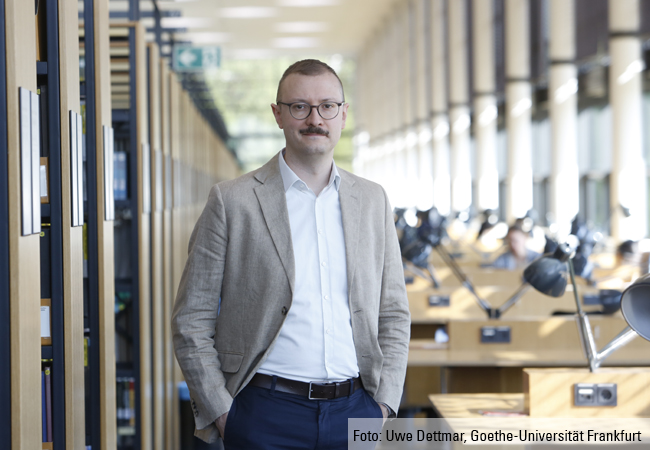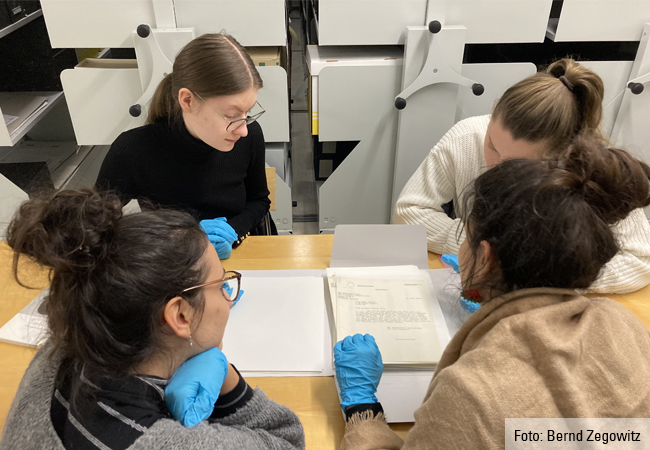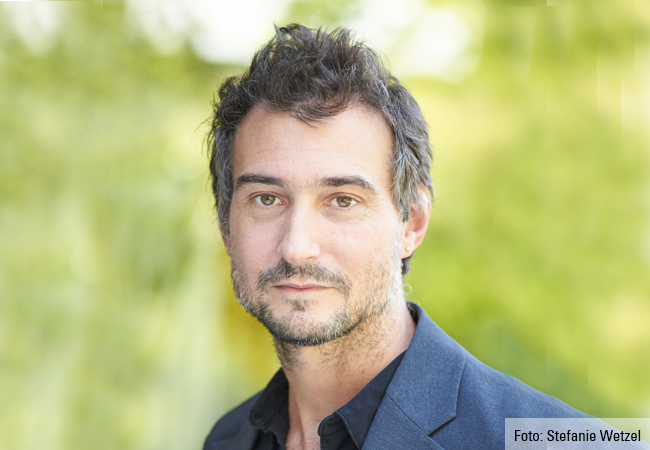Interview with Dr. Yves Vincent Grossmann, who became head of Research Data Management (RDM) at the University Library and director of the Library of Natural Sciences (BNat) in March 2024

UniReport: Dr. Grossmann, you are the new director of the Library of Natural Sciences (BNat) on Riedberg Campus. At the same time, you have taken charge of the University Library’s research data team. What opportunities do you see in this combination of library and data?
Yves Grossmann: At first glance, this combination might appear unusual. But, all things considered, I think it is logical and coherent. As far as science is concerned, research data are becoming increasingly important for the transparency of results. Not only the text but also data and software are increasingly at the focus of scientific publications, leading to a three-pillar model of publication types on which scientific findings are based: text, data, code. In many cases, it depends on the culture in the respective subject area. In the natural sciences especially, developments are clearly moving in this direction. The University Library anticipated this process and directly linked the different areas when appointing a new BNat director. I find this approach very appealing. It offers a great opportunity to develop holistic solutions for our users, for example to support them before, during and after a scientific project.
What are your goals for the first 100 days?
One of my main goals at the start was to settle in quickly at Goethe University Frankfurt as an institution and adapt to the local circumstances. I come from the Max Planck Society and worked in Munich for a long time. Both the move from a non-university research institution to a traditional and established university as well as the geographical difference between the Isar and the Main regions mean many changes. At the same time, I am pleased to be able to work with two different teams, and quickly come into contact with many different people and topics. All this has helped me personally to settle down quickly in Frankfurt and at the university. In the area of research data especially, my short-term goal is to use the restructuring process to make our team and services better known within the university, which is why this interview couldn’t have come at a better time (laughs).
What developments do you expect in the library sector in the longer term?
In the longer term, I expect that we will become even more user-oriented. The way research is conducted today, the way people teach and learn, is changing. As the University Library, we must adapt to this. To achieve this, we ourselves are undergoing a process of transformation. Key targets in our vision for 2026 include, for example, aligning our many services even more closely with users’ requirements and making them more visible. That is why it is essential for me to keep in contact with all our user groups, regardless of career level, field of activity or subject group. Only in this way can my colleagues and I offer services that meet user needs and offer genuine added value. At the same time, however, I am also aware that many developments in research infrastructures are only being felt in research, teaching and studies with some delay. The National Research Data Infrastructure (NFDI) has come up with a lot of exciting ideas. However, my observation in this context is that research software is becoming increasingly important as a frequently independent element of scientific knowledge and reproducibility. The three pillars of the model I mentioned before will converge. That is why I think that we as infrastructure providers are well advised to endeavor to anticipate such developments and to develop solutions and services together with our users.
In recent years, libraries have increasingly developed into co-working and co-learning spaces. At the same time, there are new demands placed on services supporting science. How do you combine this?
This is the pressing question the University Library is grappling with, and because of my area of responsibility, I am now actively involved in this process. Expanding and further developing the “classic” activities of librarians through new tasks such as research data management is certainly a topic discussed throughout the country. We are already looking – both within the department and at the University Library overall – at how we can put such general developments into concrete practice. Apart from research data management, this also applies to research support services surrounding open access and digital humanities, as well as new ideas for developing library facilities. It is an exciting process, and I am curious to see where we will be in a few years’ time.
For several decades now, the big buzzword for the further development of libraries has been digitalization. How does this manifest itself in your everyday work?
I hardly have any documents in paper form anymore. Almost all documents, procedures and processes are digital. That is why I disconnected the printer in my office as soon as I started at the university and returned it. At the same time, I have also noticed that the way I myself communicate has changed substantially in recent years. I hardly ever make phone calls anymore and face-to-face meetings are becoming fewer and fewer. At the same time, email and chats, but also video conferences, are becoming the increasingly dominant means of communication. Many consultations with scientists no longer take place on site but online. This is also practical to the extent that I can quickly show them things, including the interface and various tools and processes for publishing data with GUDe, our institutional data repository. In the humanities and other areas, the further digitization of books and archives might certainly be important, and the University Library is also actively involved in this. In the natural sciences, however, digitization has meanwhile become a marginal issue.
Have you got a favorite place in the Library of Natural Sciences?
I like looking down at the reading room from the gallery: lots of users and books in a long hall flooded with light. All embedded in the fascinating architecture of the Otto Stern Center.
And your favorite place at the university overall?
I am still in the process of discovering our university and its many nooks and crannies. Intuitively, I would look around on Westend Campus. But I simply have not had the chance yet to linger anywhere for long, so I would greatly welcome any tips!
Interview: Dirk Frank












